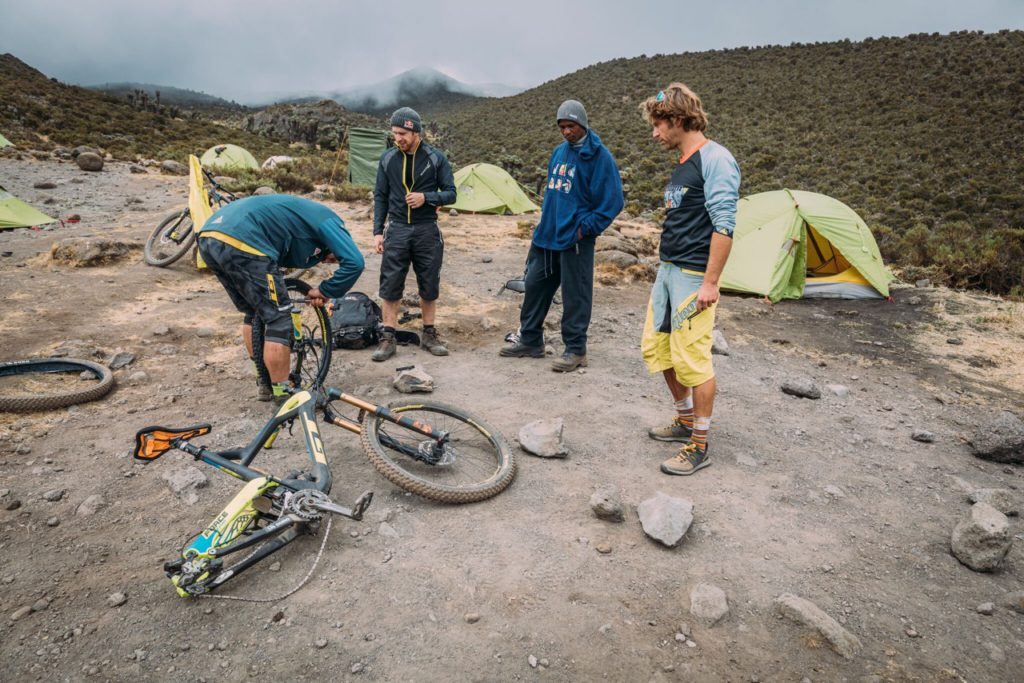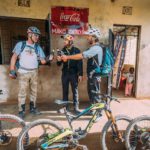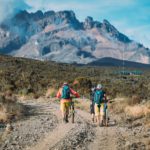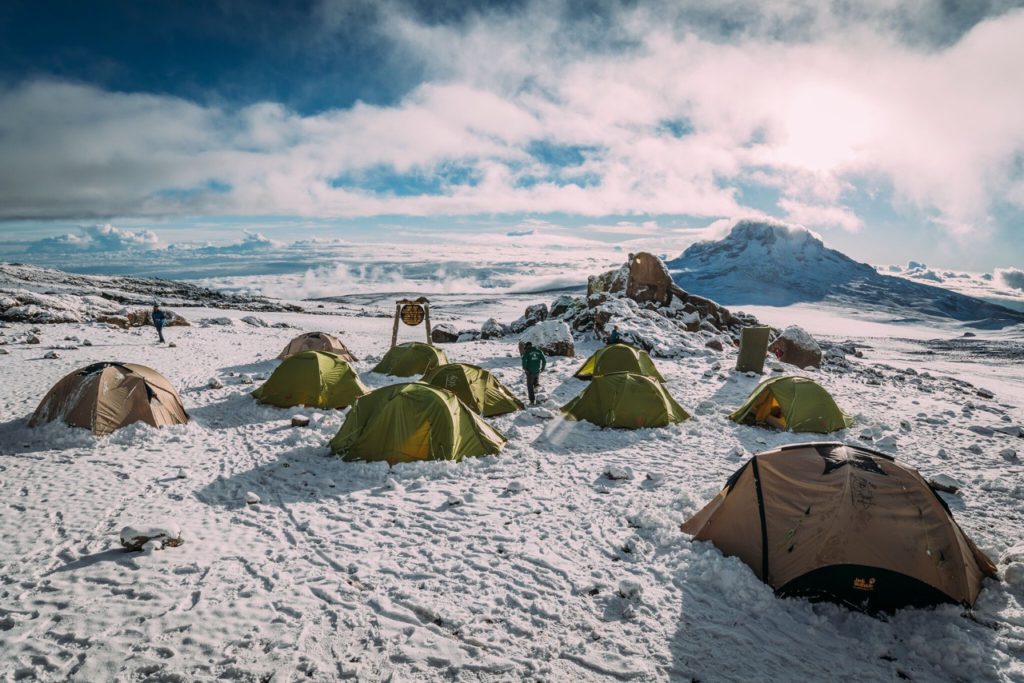Mount Kenya & Mount Kilimanjaro back to back on bikes with Hans Rey, Danny MacAskill and Gerhard Czerner
Text: Hans Rey
Photos: Martin Bissig
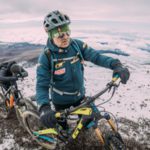 As I was putting one foot in front of the other, I kept telling myself that I have been lugging bikes up and down hills and mountains for over 30 years and if it ever mattered it would be right now, right here in the next few hours. I was a few hundred meters below Gilman’s Point, the crater rim of Mount Kilimanjaro in Africa. From where it would be another 1hour and 30 minutes to get to the true summit, the Uhuru Peak (19400ft/5,895m). At this point I had to dig deep, with fresh snow on the ground, a bike on my shoulders as well a big heavy backpack. The high altitude and oxygen deprived air made things tougher than expected. My partner on this trip, Danny MacAskill and Gerhard Czerner were struggling as well.
As I was putting one foot in front of the other, I kept telling myself that I have been lugging bikes up and down hills and mountains for over 30 years and if it ever mattered it would be right now, right here in the next few hours. I was a few hundred meters below Gilman’s Point, the crater rim of Mount Kilimanjaro in Africa. From where it would be another 1hour and 30 minutes to get to the true summit, the Uhuru Peak (19400ft/5,895m). At this point I had to dig deep, with fresh snow on the ground, a bike on my shoulders as well a big heavy backpack. The high altitude and oxygen deprived air made things tougher than expected. My partner on this trip, Danny MacAskill and Gerhard Czerner were struggling as well.
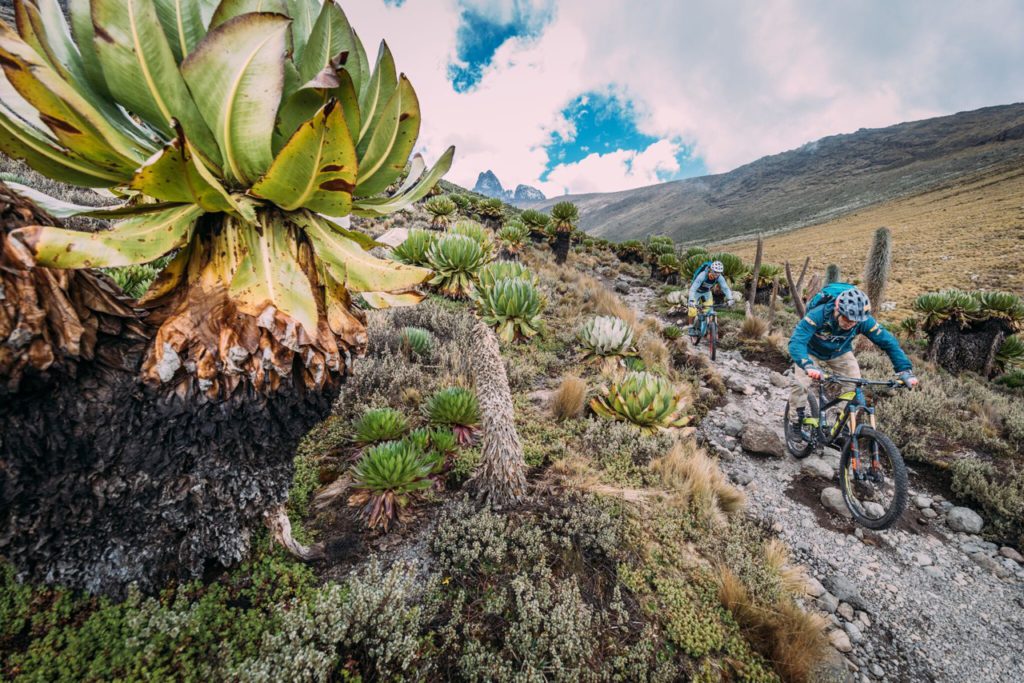 I had heard of so many hikers that have walked up Africa’s highest mountain, I figured it couldn’t be that hard. I didn’t take into consideration that most of the hikers don’t carry much. Hauling our own bikes and day packs, alpine style, made a huge – 50 lbs – difference and made this trip super hard, not to forget that only days before some of us had already successfully ridden Mount Kenya – Africa second highest mountain.
I had heard of so many hikers that have walked up Africa’s highest mountain, I figured it couldn’t be that hard. I didn’t take into consideration that most of the hikers don’t carry much. Hauling our own bikes and day packs, alpine style, made a huge – 50 lbs – difference and made this trip super hard, not to forget that only days before some of us had already successfully ridden Mount Kenya – Africa second highest mountain.
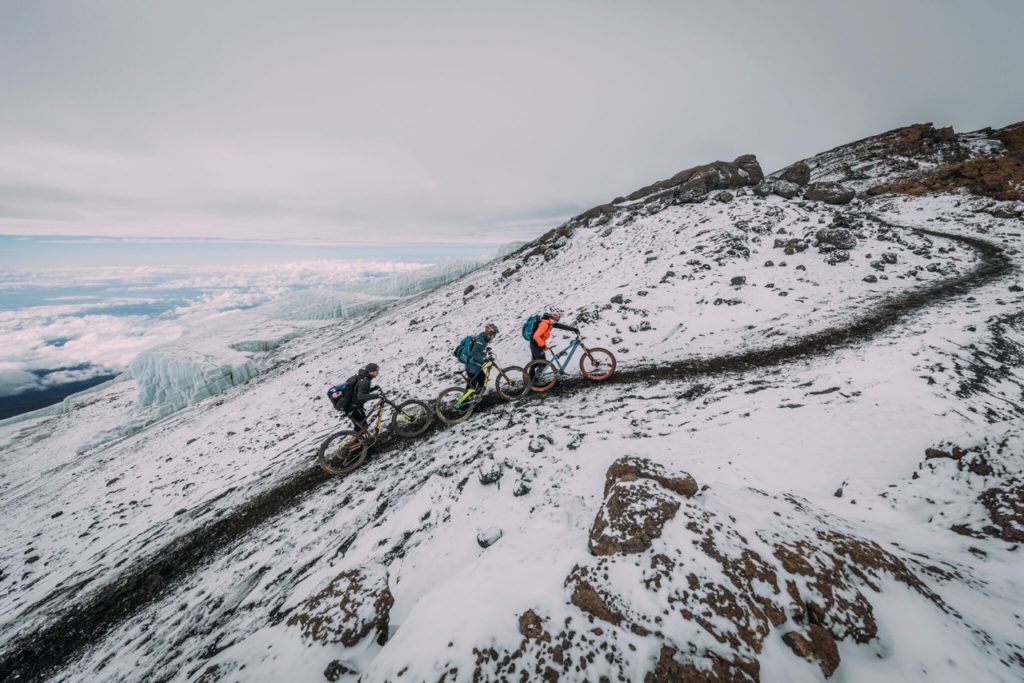 When we first arrived in Nairobi 10 days prior, we met up with our crew and team. Besides us riders, we were joined by photographer Martin Bissig as well as Ae-ron, Axel and Greg from Freeride Enterment Productions, who where filming for a TV documentary and an upcoming (2018) film about the history of ‘Freeride’ – “Nothin For Free”, for which it was planned to film my interviews on top of the mountains. For parts of the trip we were also joined by a friend of Gerhard’s who is a experienced mountaineer connected to the touring company we had hired for Kilimanjaro to help us with logistics and porters. They had urged us to do an acclimation trip prior to Kili on nearby Mount Meru, to get accustomed to the thin air. Only days before the trip we found out that Mount Meru wouldn’t allow bikes within its National Park boundaries. Not in the mood for a 4-day hiking trip, we changed our itinerary last minute and decided to climb instead Mount Kenya first, where bikes are allowed. As a matter of fact, in 2004 I was the first person with Richie Schley to ride bikes from Point Lenana Summit at Mount Kenya. It was a hard trip that took 7 days and tested our limits. In the 12 years that have passed since, I had forgotten the pain and hardship. As matter of fact, because we were pressed for time, and since we couldn’t change the start date of our Kilimanjaro climb, we decided to try to summit and descent Mount Kenya in only 4 days. Anybody who knows anything about high altitude understands that we’d be pushing our luck and would be jeopardizing the entire expedition.
When we first arrived in Nairobi 10 days prior, we met up with our crew and team. Besides us riders, we were joined by photographer Martin Bissig as well as Ae-ron, Axel and Greg from Freeride Enterment Productions, who where filming for a TV documentary and an upcoming (2018) film about the history of ‘Freeride’ – “Nothin For Free”, for which it was planned to film my interviews on top of the mountains. For parts of the trip we were also joined by a friend of Gerhard’s who is a experienced mountaineer connected to the touring company we had hired for Kilimanjaro to help us with logistics and porters. They had urged us to do an acclimation trip prior to Kili on nearby Mount Meru, to get accustomed to the thin air. Only days before the trip we found out that Mount Meru wouldn’t allow bikes within its National Park boundaries. Not in the mood for a 4-day hiking trip, we changed our itinerary last minute and decided to climb instead Mount Kenya first, where bikes are allowed. As a matter of fact, in 2004 I was the first person with Richie Schley to ride bikes from Point Lenana Summit at Mount Kenya. It was a hard trip that took 7 days and tested our limits. In the 12 years that have passed since, I had forgotten the pain and hardship. As matter of fact, because we were pressed for time, and since we couldn’t change the start date of our Kilimanjaro climb, we decided to try to summit and descent Mount Kenya in only 4 days. Anybody who knows anything about high altitude understands that we’d be pushing our luck and would be jeopardizing the entire expedition.
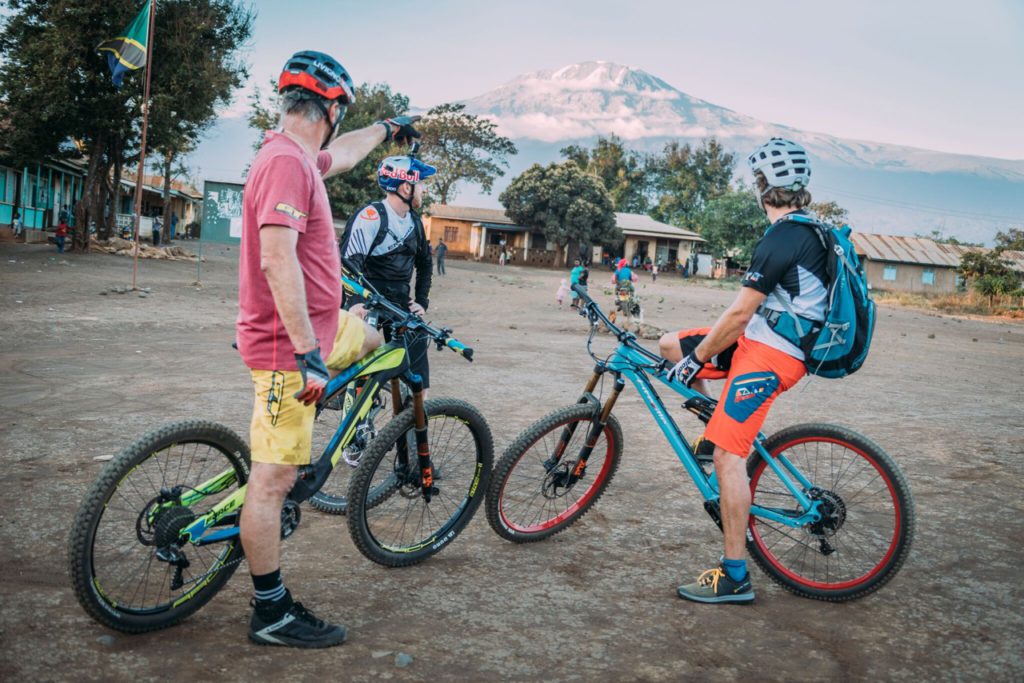 But first to kick off our trip, we had scheduled a philantrophic visit at one of the communities that my charity, Wheels 4 Life, has supported with bicycles in the past. We had arranged for delivery of 50 additional bicycles to be distributed during our visit with Bishop Kamau and to also meet some of the folks who had received bikes from our non-profit in the past, to see and hear first hand how those bikes have changed the lives of many.
But first to kick off our trip, we had scheduled a philantrophic visit at one of the communities that my charity, Wheels 4 Life, has supported with bicycles in the past. We had arranged for delivery of 50 additional bicycles to be distributed during our visit with Bishop Kamau and to also meet some of the folks who had received bikes from our non-profit in the past, to see and hear first hand how those bikes have changed the lives of many.
 Our usual bike recipients are poor people in need of transportation; like school children who walk up to 10km to school each day, healthcare workers or farmers who use the bikes to bring goods to market. Having mobility in form of a bicycle makes all the difference for people who don’t have or can’t afford alternative/ public transportation. One man, his man is Simon, was given a bike by us 3 years ago when he lived in a simple mud hut. Because of the bike he could get to and find occasional work in a town 15km away. He has earned enough money, that he now lives in a tin roofed house, with furniture, and has his own cow and two goats. His children are able to go to school.
Our usual bike recipients are poor people in need of transportation; like school children who walk up to 10km to school each day, healthcare workers or farmers who use the bikes to bring goods to market. Having mobility in form of a bicycle makes all the difference for people who don’t have or can’t afford alternative/ public transportation. One man, his man is Simon, was given a bike by us 3 years ago when he lived in a simple mud hut. Because of the bike he could get to and find occasional work in a town 15km away. He has earned enough money, that he now lives in a tin roofed house, with furniture, and has his own cow and two goats. His children are able to go to school.
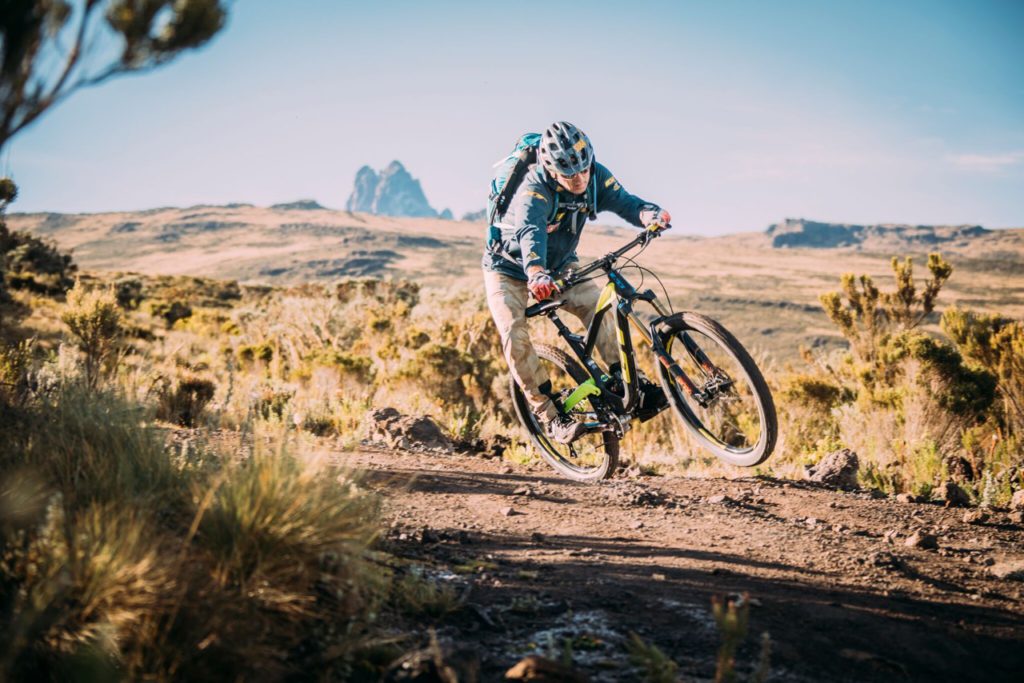
Another lady who had gotten one of our bikes told us that she has had health problems and because of the bike she could get regular healthcare attention.
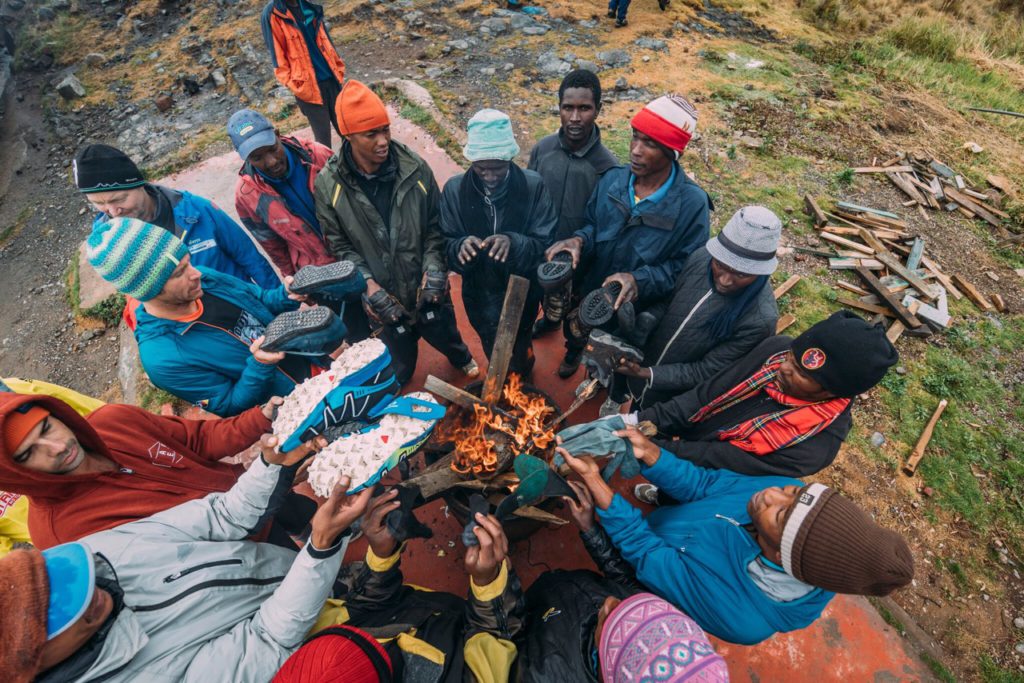 The highlight for the kids and folks who didn’t get a bike was a little impromptu trick show from Danny. Danny is probably the most famous mountain biker in the world, from his famous Youtube videos that have been seen by millions and millions. If people didn’t’ know about him already, which was likely in this village one hour west of Nairobi, since internet access is still a novelty to most of the people in Africa, they will certainly not forget him soon, after watching him doing some amazing tricks.
The highlight for the kids and folks who didn’t get a bike was a little impromptu trick show from Danny. Danny is probably the most famous mountain biker in the world, from his famous Youtube videos that have been seen by millions and millions. If people didn’t’ know about him already, which was likely in this village one hour west of Nairobi, since internet access is still a novelty to most of the people in Africa, they will certainly not forget him soon, after watching him doing some amazing tricks.
 The next morning we had a long vehicle transfer to the town of Timau at the northern base of Mount Kenya, where we met our contacts from Rift Valley Adventures and the Mount Kenya Trust, who both offered us their help and support, immediately after receiving my email request only days before.
The next morning we had a long vehicle transfer to the town of Timau at the northern base of Mount Kenya, where we met our contacts from Rift Valley Adventures and the Mount Kenya Trust, who both offered us their help and support, immediately after receiving my email request only days before.
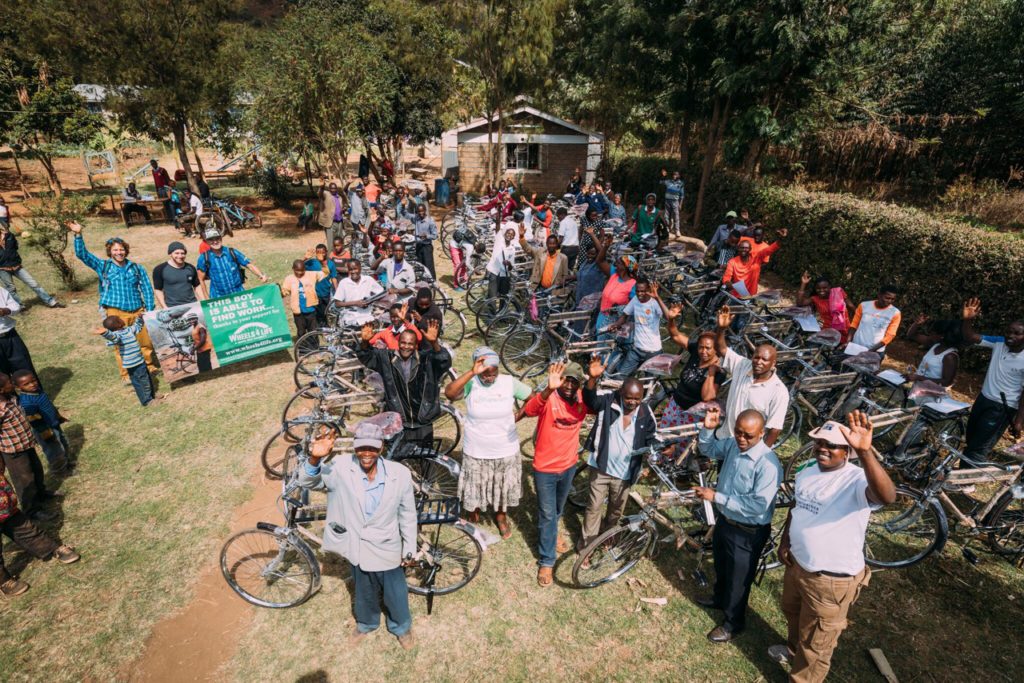 Mount Kenya has several peaks; Point Lenana (16’700ft/4,985m) is the third tallest and known as the trekkers’ summit, since one can reach it without robes and rock climbing skills. These African mountains are amazing, at first they rise very gradually, eventually the terrain gets steeper and rocky. The beautiful thing about traversing Mount Kenya, we climbed the Sirimon route and rode down the Chogoria route, are all the different climate zones and diverse ecosystems one crosses. They say every day is summer and winter on Mount Kenya, the mornings are often sunny and warm(er) and usually clouds move in around midday bringing rain and snow. The vegetation on each side of the mountain varies a lot, since the climate on the northern side, where we started, is much drier than on the lush southern slopes where we’d ride down.
Mount Kenya has several peaks; Point Lenana (16’700ft/4,985m) is the third tallest and known as the trekkers’ summit, since one can reach it without robes and rock climbing skills. These African mountains are amazing, at first they rise very gradually, eventually the terrain gets steeper and rocky. The beautiful thing about traversing Mount Kenya, we climbed the Sirimon route and rode down the Chogoria route, are all the different climate zones and diverse ecosystems one crosses. They say every day is summer and winter on Mount Kenya, the mornings are often sunny and warm(er) and usually clouds move in around midday bringing rain and snow. The vegetation on each side of the mountain varies a lot, since the climate on the northern side, where we started, is much drier than on the lush southern slopes where we’d ride down.
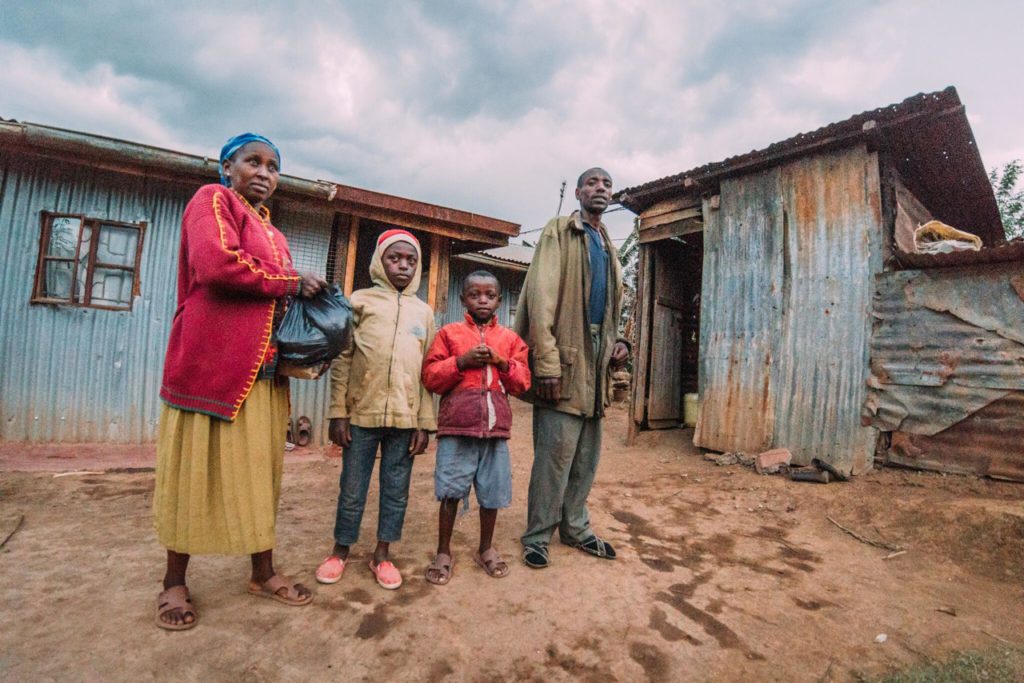 Danny was the youngest and least experienced altitude rider on our team, however, he was also the strongest and best bike handler. He had never been higher than 3000m , which is only half the height of Kilimanjaro. He decided, just like Gerhard and some others in our team not to take any Diamox, which helps the body to adjust to high altitude and lowers the risk of getting sick. Little did he understand that once a person gets altitude sickness, it can be very bad, actually life threatening.
Danny was the youngest and least experienced altitude rider on our team, however, he was also the strongest and best bike handler. He had never been higher than 3000m , which is only half the height of Kilimanjaro. He decided, just like Gerhard and some others in our team not to take any Diamox, which helps the body to adjust to high altitude and lowers the risk of getting sick. Little did he understand that once a person gets altitude sickness, it can be very bad, actually life threatening.
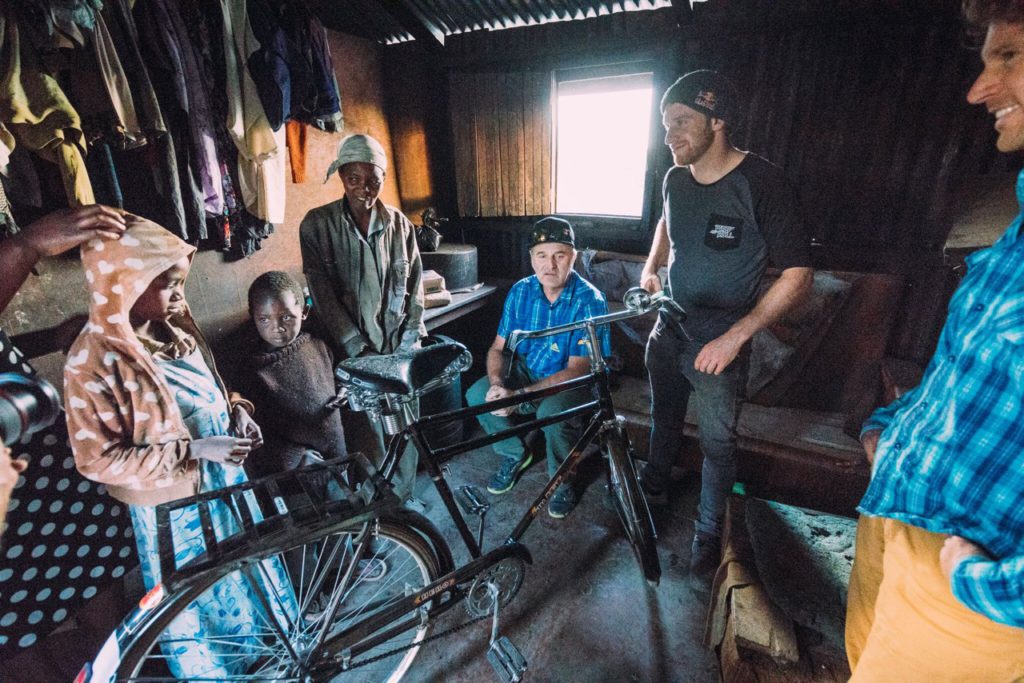 Thomas, Gerhard’s friend who joined us on that part of the trip, gave us some valuable advice for dealing with thin air, namely by going very slow and easy and carry as little weight as possible. Which was easier said than done, since we all had set as our goals to ride and carry our own bikes and daypack at all time, while the porters would carry our food supplies, extra gear, and camera equipment. They would also help our film and photo crew with their bikes from time to time, since they had the hardest job, not only climbing those mountains, but also documenting everything in the process. We also learned some interesting breathing techniques that helped us get more oxygen in our body, which would help our muscles and brain to function better. At high altitude its easy to feel the thin air and get out of breath from the smallest effort, the thing most people don’t know and what often leads to acute mountain sickness (AMS); is that when one goes too hard or too high, you usually don’t pay the price immediately, but 24 hours later and it will hit you like a right hook from Mike Tyson, at which point the only solution is to backtrack down to lower elevation to avoid getting even sicker, like high altitude pulmonary edema.
Thomas, Gerhard’s friend who joined us on that part of the trip, gave us some valuable advice for dealing with thin air, namely by going very slow and easy and carry as little weight as possible. Which was easier said than done, since we all had set as our goals to ride and carry our own bikes and daypack at all time, while the porters would carry our food supplies, extra gear, and camera equipment. They would also help our film and photo crew with their bikes from time to time, since they had the hardest job, not only climbing those mountains, but also documenting everything in the process. We also learned some interesting breathing techniques that helped us get more oxygen in our body, which would help our muscles and brain to function better. At high altitude its easy to feel the thin air and get out of breath from the smallest effort, the thing most people don’t know and what often leads to acute mountain sickness (AMS); is that when one goes too hard or too high, you usually don’t pay the price immediately, but 24 hours later and it will hit you like a right hook from Mike Tyson, at which point the only solution is to backtrack down to lower elevation to avoid getting even sicker, like high altitude pulmonary edema.
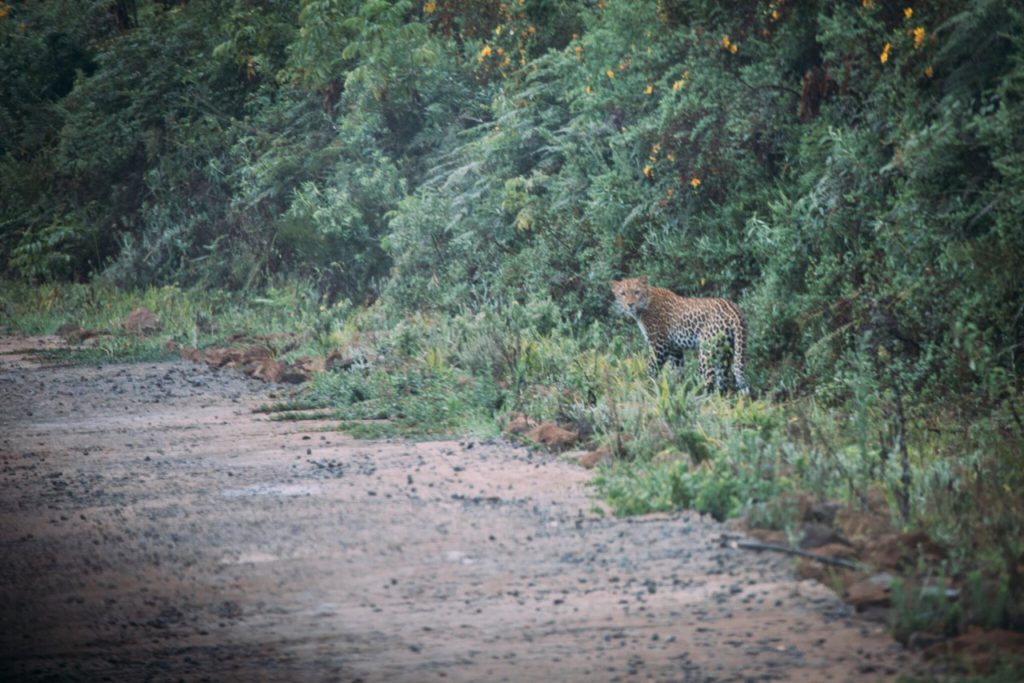 As soon as we arrived at the Sirimon Park Gate to sign in with the Park authorities, it promptly started pouring rain. After waiting around unsuccessfully for better weather for one hour, we dressed up in our rain gear and started the dirt road up the hill towards Old Moses Camp. Not the way we pictured our 12-day trip to start, but we had to be ready for it and worse, since it was the beginning of the rainy season bad weather was in our cards from the get go. Only a few kilometers after our start we crossed the Equator line, slowly moving uphill while keeping our eyes open for wildlife. After 4 hours in the rain we arrived at the camp with primitive huts and very simple bunk beds, where dozens of hikers had already set up for the night. By now the rain had stopped, and we knew this was the last chance for an open fire where we could dry our clothes and shoes, further up the mountain fires weren’t allowed nor was firewood available. After we settled in camp, we did a short hike further up the mountain, for better acclimation, while our guides and porters from Rift Valley Adventures prepared the food. Day two was a long stage, not only in distance but also in altitude gain; we would climb from 3300m to Shipton Camp at 4200m.
As soon as we arrived at the Sirimon Park Gate to sign in with the Park authorities, it promptly started pouring rain. After waiting around unsuccessfully for better weather for one hour, we dressed up in our rain gear and started the dirt road up the hill towards Old Moses Camp. Not the way we pictured our 12-day trip to start, but we had to be ready for it and worse, since it was the beginning of the rainy season bad weather was in our cards from the get go. Only a few kilometers after our start we crossed the Equator line, slowly moving uphill while keeping our eyes open for wildlife. After 4 hours in the rain we arrived at the camp with primitive huts and very simple bunk beds, where dozens of hikers had already set up for the night. By now the rain had stopped, and we knew this was the last chance for an open fire where we could dry our clothes and shoes, further up the mountain fires weren’t allowed nor was firewood available. After we settled in camp, we did a short hike further up the mountain, for better acclimation, while our guides and porters from Rift Valley Adventures prepared the food. Day two was a long stage, not only in distance but also in altitude gain; we would climb from 3300m to Shipton Camp at 4200m. 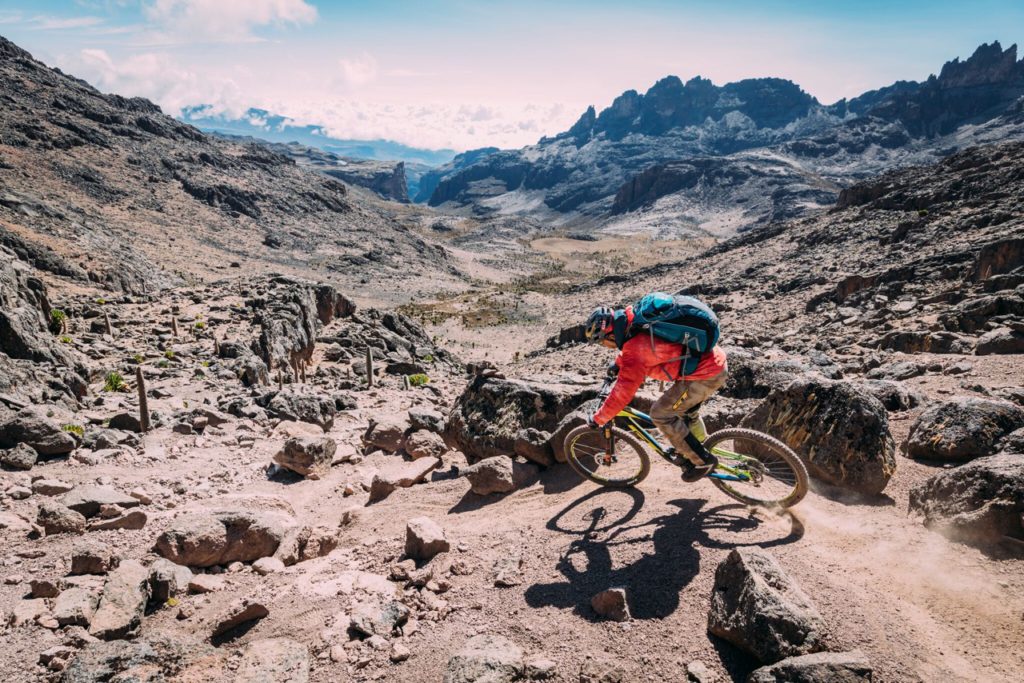 It doesn’t sound much on paper, but it worried our guides and we soon would get to feel it. We had started at first light around 6am, in order to minimize the chances of getting wet by afternoon rain. Halfway through the day we started feeling the effect of the altitude, despite all us doing our breathing techniques; exhaling like a locomotive, freeing our lungs of CO2 to make room for more oxygen. Danny started to loose the color in his face and faded quickly, still hours from the camp with the rain clouds moving in. We reduced our pace even more and slowly walked and sometimes rode our bikes up the Mackinder Valley towards camp. The vegetation was beautiful with giant lobelia plants that only grow at 3 or 4 places in the world at high elevation in the Afro-alpine zone. After a nearly 10 hour day on the trails, we arrived at the camp, where we had scheduled two nights, to acclimate better before our summit push and descent which was planned on day 4. Danny struggled but all of us had the hardship of this strenuous day written on their faces and could feel it in every limb of their body. It was harder than some of us expected and this was only day two of ten or eleven days. Shortly after dinner, everybody went to bed. Danny had a night from hell, and his condition got worse over night. Our guides started to become seriously concerned; there were lots of talk and discussions of changing the route, itinerary and some even suggested to not go for the summit and save ourselves for Kili.
It doesn’t sound much on paper, but it worried our guides and we soon would get to feel it. We had started at first light around 6am, in order to minimize the chances of getting wet by afternoon rain. Halfway through the day we started feeling the effect of the altitude, despite all us doing our breathing techniques; exhaling like a locomotive, freeing our lungs of CO2 to make room for more oxygen. Danny started to loose the color in his face and faded quickly, still hours from the camp with the rain clouds moving in. We reduced our pace even more and slowly walked and sometimes rode our bikes up the Mackinder Valley towards camp. The vegetation was beautiful with giant lobelia plants that only grow at 3 or 4 places in the world at high elevation in the Afro-alpine zone. After a nearly 10 hour day on the trails, we arrived at the camp, where we had scheduled two nights, to acclimate better before our summit push and descent which was planned on day 4. Danny struggled but all of us had the hardship of this strenuous day written on their faces and could feel it in every limb of their body. It was harder than some of us expected and this was only day two of ten or eleven days. Shortly after dinner, everybody went to bed. Danny had a night from hell, and his condition got worse over night. Our guides started to become seriously concerned; there were lots of talk and discussions of changing the route, itinerary and some even suggested to not go for the summit and save ourselves for Kili.
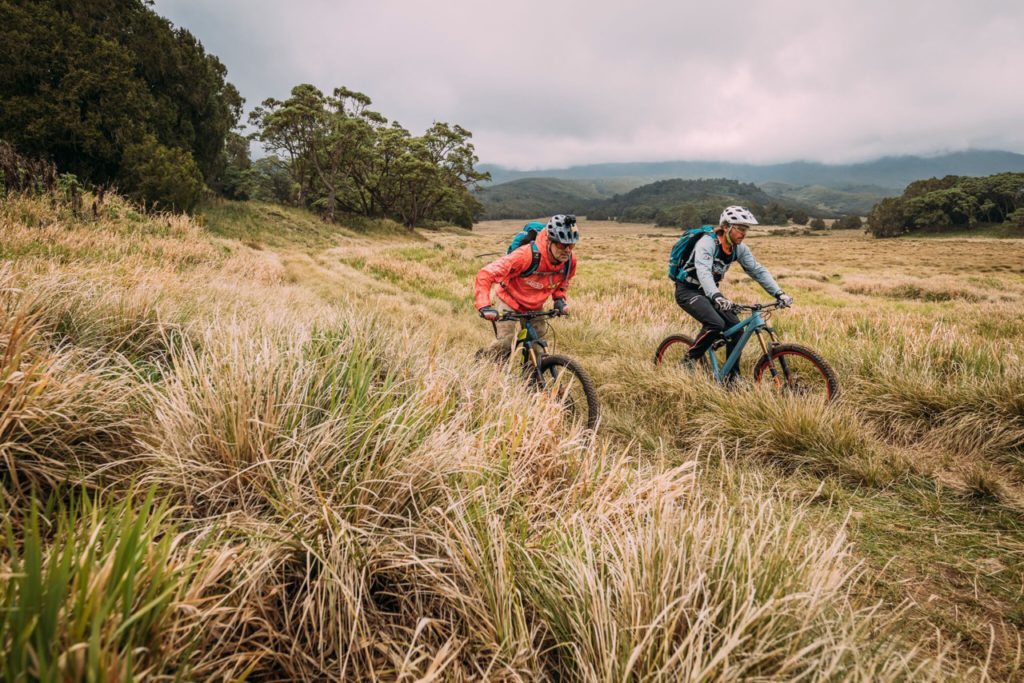 We knew we wouldn’t be the first bikers to summit Kilimanjaro, a few parties had already done it before us; the first descent with bikes was 25 years ago. Not sure how much they have ridden on the way down on those old school bikes, but they did bring their bikes all the way to the top. Therefore, we set our goal even higher to be the first to summit both of Africa’s highest points, back to back with bikes. Maybe slightly overambitious.
We knew we wouldn’t be the first bikers to summit Kilimanjaro, a few parties had already done it before us; the first descent with bikes was 25 years ago. Not sure how much they have ridden on the way down on those old school bikes, but they did bring their bikes all the way to the top. Therefore, we set our goal even higher to be the first to summit both of Africa’s highest points, back to back with bikes. Maybe slightly overambitious.
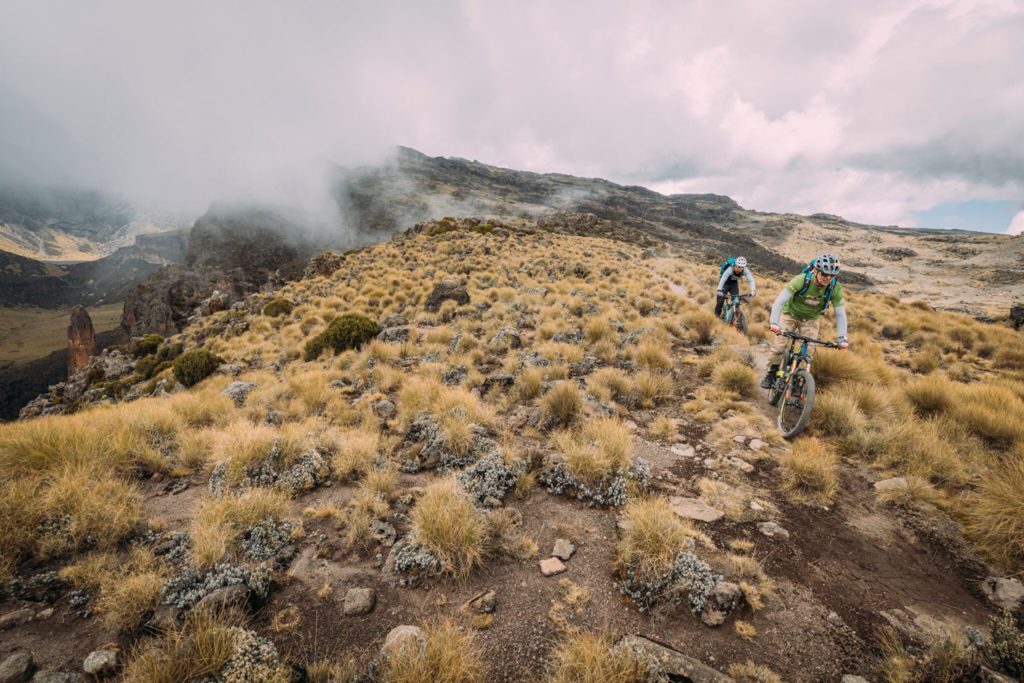 I wanted to summit Mount Kenya again and I wanted to descent down the backside on the Chogoria route, which winds over 30km through the most diverse landscape on this planet, and which I had climbed up on my previous trip.
I wanted to summit Mount Kenya again and I wanted to descent down the backside on the Chogoria route, which winds over 30km through the most diverse landscape on this planet, and which I had climbed up on my previous trip.
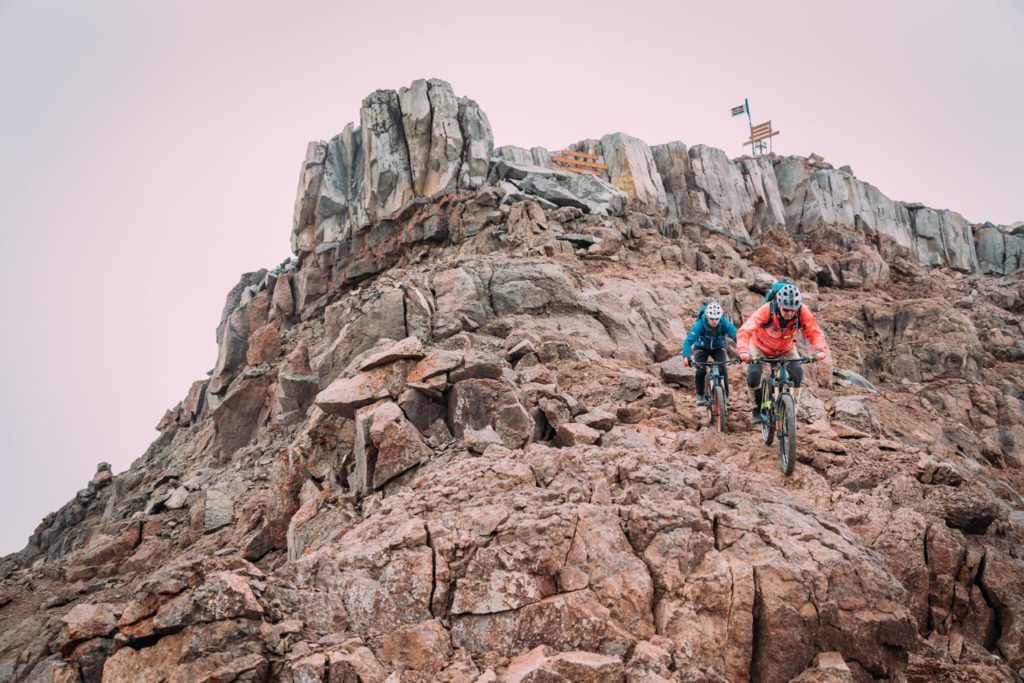 After a series of events and circumstances and some misinformation we had received, we made a quick, but important decision. Instead of having a rest day, we would try to summit today and come back to the same camp. We decided to save Danny for Kilimanjaro, he had not the strength to join us and it didn’t look like he would get better the following day. We left him and part of the camera team behind at the camp. Gerhard and myself and our local guides started the 3,5hour steep grind towards the top with our bikes, while Axel and Martin joined on foot to capture our attempt. The ground was rocky and loose and completely unridable on the way up. Clouds kept moving in and out, the temperature would change, but as luck would have it, we didn’t get rained or snowed on. On Wednesday the 26th of October at around 2pm we reached the summit. It was a wonderful feeling and it felt incredible to be up there again. The Lewis glacier which is located between the summit peaks of Mount Kenya had shrunk in size over 40% since I last saw it in 2004. After a short moment on the summit, taking in the endless panoramic views and taking a bunch of selfies with the summit sign in the background, we turned our bikes around to start what we had really come here for. The descent.
After a series of events and circumstances and some misinformation we had received, we made a quick, but important decision. Instead of having a rest day, we would try to summit today and come back to the same camp. We decided to save Danny for Kilimanjaro, he had not the strength to join us and it didn’t look like he would get better the following day. We left him and part of the camera team behind at the camp. Gerhard and myself and our local guides started the 3,5hour steep grind towards the top with our bikes, while Axel and Martin joined on foot to capture our attempt. The ground was rocky and loose and completely unridable on the way up. Clouds kept moving in and out, the temperature would change, but as luck would have it, we didn’t get rained or snowed on. On Wednesday the 26th of October at around 2pm we reached the summit. It was a wonderful feeling and it felt incredible to be up there again. The Lewis glacier which is located between the summit peaks of Mount Kenya had shrunk in size over 40% since I last saw it in 2004. After a short moment on the summit, taking in the endless panoramic views and taking a bunch of selfies with the summit sign in the background, we turned our bikes around to start what we had really come here for. The descent.
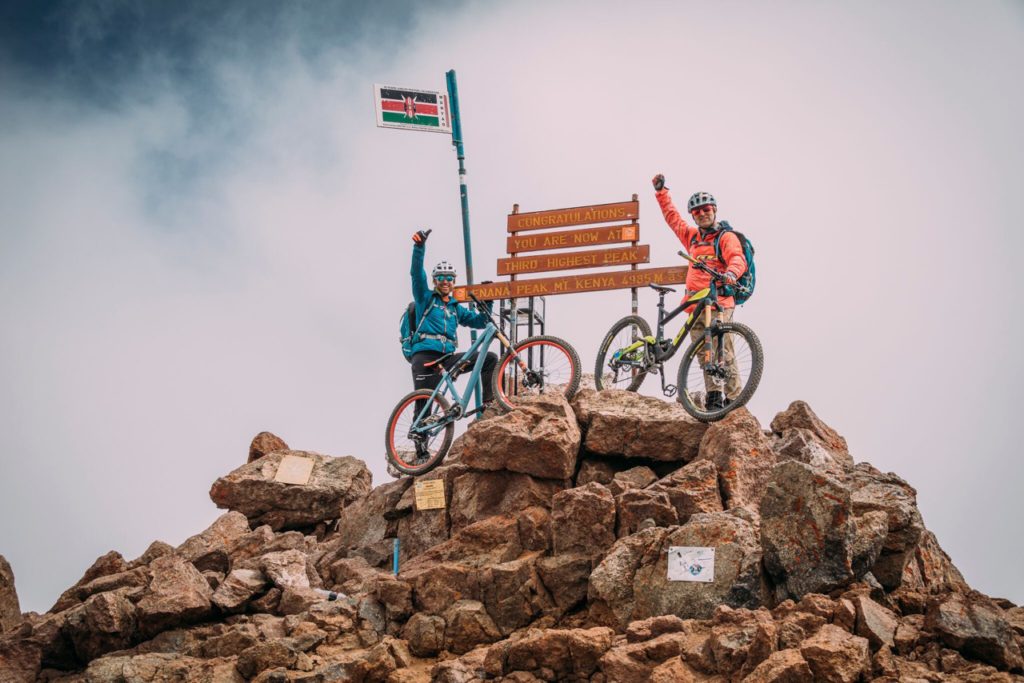 The first section near the top was rather steep, rocky and exposed. For lack of strength, safety and lack of trail we had to walk a few short sections, but the great majority of the trail was rideable and super fun. At first we needed to put our trials skills to the test; luckily Gerhard has also a trials riding background and loves riding technical terrain. Soon the terrain would mellow and we could surf down the steep gravel slopes, similar than a free skier, except we were surrounded by dust not powder. Effortless we bombed down the mountain, and our breathing felt a little better with every meter. Danny watched us come down the last hillside that is visible from the camp, his condition hadn’t improved.. The bad news was, that in order to get to the Chogoria route the following day, we first had to climb up again. We knew it would be long way down, but nobody quite knew how much climbing was ahead of us on the way down. At this point we already had arranged for the porters to carry the bikes of the film crew to a certain point on the Chogoria route from where they could, or we thought so, ride down. By having moved the bikes of the crew to a point partly down the Chogoria route, we were committed to this route, but Danny’s condition rapidly got worse. His heart rate went through the roof just walking 50 feet uphill from camp and his blood oxygen levels were very low. His cough sounded like he had fluid built up in his lungs. These were the first signs of pulmonary edema. Normally one just goes 500m lower and the condition often improves right away. Staying at altitude or even going higher, which we planned on doing the next day, could be very dangerous if not deadly. The problem was, it wasn’t possible to just go down, on the way up with had to go up and down several valleys, to get lower, at night, in the rain was also risky. It would have been a 6-hour hike in the dark with several steep uphill sections. Several porters had volunteered to walk down with him, against the consent of the rangers stationed at the hut, we went with the proposal from Thomas to spend the night at the hut and arrange for a rescue helicopter at first light in the morning. This was a very risky decision, to stay for the night. With a heavy heart I watched the helicopter land in the morning, only moments later, Danny was gone. I didn’t expect to see him again on this trip. I was sure that he wouldn’t recover in time to attempt Kili only 3 days later. Danny was gutted. It all happened so fast. It wasn’t the same to start our last day and big descent on Mount Kenya without him. We broke camp and started our climb to the other side of the ridge. It was a lot longer and harder than we were told, at freezing temperatures we climbed for 2 hours to Simba Col. But if you think it was all downhill from there, you are wrong. There was no way that Danny could have handled that climb in his condition. The downhill started very steep and technical, plus we had to traverse a long valley before we eventually reached the bikes of the crew at Minto’s Hut. We were still hours and hours from the Bandas at the base near the end of the Chogoria route. The trail was very technical: ‘expert riders only’. The crew with their heavy backpacks was not happy. The downhill riding seemed just as strenuous as the uphill riding.
The first section near the top was rather steep, rocky and exposed. For lack of strength, safety and lack of trail we had to walk a few short sections, but the great majority of the trail was rideable and super fun. At first we needed to put our trials skills to the test; luckily Gerhard has also a trials riding background and loves riding technical terrain. Soon the terrain would mellow and we could surf down the steep gravel slopes, similar than a free skier, except we were surrounded by dust not powder. Effortless we bombed down the mountain, and our breathing felt a little better with every meter. Danny watched us come down the last hillside that is visible from the camp, his condition hadn’t improved.. The bad news was, that in order to get to the Chogoria route the following day, we first had to climb up again. We knew it would be long way down, but nobody quite knew how much climbing was ahead of us on the way down. At this point we already had arranged for the porters to carry the bikes of the film crew to a certain point on the Chogoria route from where they could, or we thought so, ride down. By having moved the bikes of the crew to a point partly down the Chogoria route, we were committed to this route, but Danny’s condition rapidly got worse. His heart rate went through the roof just walking 50 feet uphill from camp and his blood oxygen levels were very low. His cough sounded like he had fluid built up in his lungs. These were the first signs of pulmonary edema. Normally one just goes 500m lower and the condition often improves right away. Staying at altitude or even going higher, which we planned on doing the next day, could be very dangerous if not deadly. The problem was, it wasn’t possible to just go down, on the way up with had to go up and down several valleys, to get lower, at night, in the rain was also risky. It would have been a 6-hour hike in the dark with several steep uphill sections. Several porters had volunteered to walk down with him, against the consent of the rangers stationed at the hut, we went with the proposal from Thomas to spend the night at the hut and arrange for a rescue helicopter at first light in the morning. This was a very risky decision, to stay for the night. With a heavy heart I watched the helicopter land in the morning, only moments later, Danny was gone. I didn’t expect to see him again on this trip. I was sure that he wouldn’t recover in time to attempt Kili only 3 days later. Danny was gutted. It all happened so fast. It wasn’t the same to start our last day and big descent on Mount Kenya without him. We broke camp and started our climb to the other side of the ridge. It was a lot longer and harder than we were told, at freezing temperatures we climbed for 2 hours to Simba Col. But if you think it was all downhill from there, you are wrong. There was no way that Danny could have handled that climb in his condition. The downhill started very steep and technical, plus we had to traverse a long valley before we eventually reached the bikes of the crew at Minto’s Hut. We were still hours and hours from the Bandas at the base near the end of the Chogoria route. The trail was very technical: ‘expert riders only’. The crew with their heavy backpacks was not happy. The downhill riding seemed just as strenuous as the uphill riding.  It was hard. It was beautiful. The landscape changed constantly every few kilometers. This is why Mount Kenya is one of my favorite rides ever. Combined with the challenging terrain, adventure and culture this is as rad as it gets. The downhill wasn’t easy by any means, loose rocks for miles, blocked and rutted trails, and plenty of opportunity to hook your pedals. Key was to keep momentum to save energy, further down the bushes got dense and the ruts – which often were the only possible line – were head high. Starting in the barren Alpine we descent to the Afro-alpine which had more vegetation as lower we rode, eventually we crossed the heathland and chaparral and moorlands eventually we rode through these beautiful rosewood forests, that remind one of a fairytale setting. Now we were on the lookout for wildlife again, sure enough we got to see a small herd of water-buffalo and antelopes. It was an amazing display of constantly changing landscapes. At this point we were riding on an old 4×4 road, that what actually quite fun and fast, compared to the slow pace we had most of the day on the technical trail. Right as we entered the bamboo forest we also reached our camp and end point for our traverse, the Bandas. It was a long and exhausting day. The first part of our mission was accomplished. After a beer and shower, I found a certain tree near the huts, which was the only spot where one could catch, with some luck and the right cloud layer, a phone signal. In the dark while it was raining I had to climb up a sketchy wooden ladder and hold my phone high in the air. Eventually I got a phone signal and could call Danny who was on the other side of the mountain where we had started. The good news was, that he started to feel better as soon the heli dropped him at lower altitude. He spent most of the day at the hospital getting checked up. After thorough examinations they put him on antibiotics and released him. To my surprise he said, “I want to give Kilimanjaro a try”. We figured he could take it easy the first few days on Kilimanjaro, and if the fluid in his lungs disappeared he should be good for a summit attempt. Kilimanjaro had one advantage, even though it is 1000m/3000ft higher, when things go bad, it’s easy to turn around and ride to lower elevation for recovery. I was so happy that Danny would join us again. We arranged to meet him the next day along the route on the way to Tanzania.
It was hard. It was beautiful. The landscape changed constantly every few kilometers. This is why Mount Kenya is one of my favorite rides ever. Combined with the challenging terrain, adventure and culture this is as rad as it gets. The downhill wasn’t easy by any means, loose rocks for miles, blocked and rutted trails, and plenty of opportunity to hook your pedals. Key was to keep momentum to save energy, further down the bushes got dense and the ruts – which often were the only possible line – were head high. Starting in the barren Alpine we descent to the Afro-alpine which had more vegetation as lower we rode, eventually we crossed the heathland and chaparral and moorlands eventually we rode through these beautiful rosewood forests, that remind one of a fairytale setting. Now we were on the lookout for wildlife again, sure enough we got to see a small herd of water-buffalo and antelopes. It was an amazing display of constantly changing landscapes. At this point we were riding on an old 4×4 road, that what actually quite fun and fast, compared to the slow pace we had most of the day on the technical trail. Right as we entered the bamboo forest we also reached our camp and end point for our traverse, the Bandas. It was a long and exhausting day. The first part of our mission was accomplished. After a beer and shower, I found a certain tree near the huts, which was the only spot where one could catch, with some luck and the right cloud layer, a phone signal. In the dark while it was raining I had to climb up a sketchy wooden ladder and hold my phone high in the air. Eventually I got a phone signal and could call Danny who was on the other side of the mountain where we had started. The good news was, that he started to feel better as soon the heli dropped him at lower altitude. He spent most of the day at the hospital getting checked up. After thorough examinations they put him on antibiotics and released him. To my surprise he said, “I want to give Kilimanjaro a try”. We figured he could take it easy the first few days on Kilimanjaro, and if the fluid in his lungs disappeared he should be good for a summit attempt. Kilimanjaro had one advantage, even though it is 1000m/3000ft higher, when things go bad, it’s easy to turn around and ride to lower elevation for recovery. I was so happy that Danny would join us again. We arranged to meet him the next day along the route on the way to Tanzania. 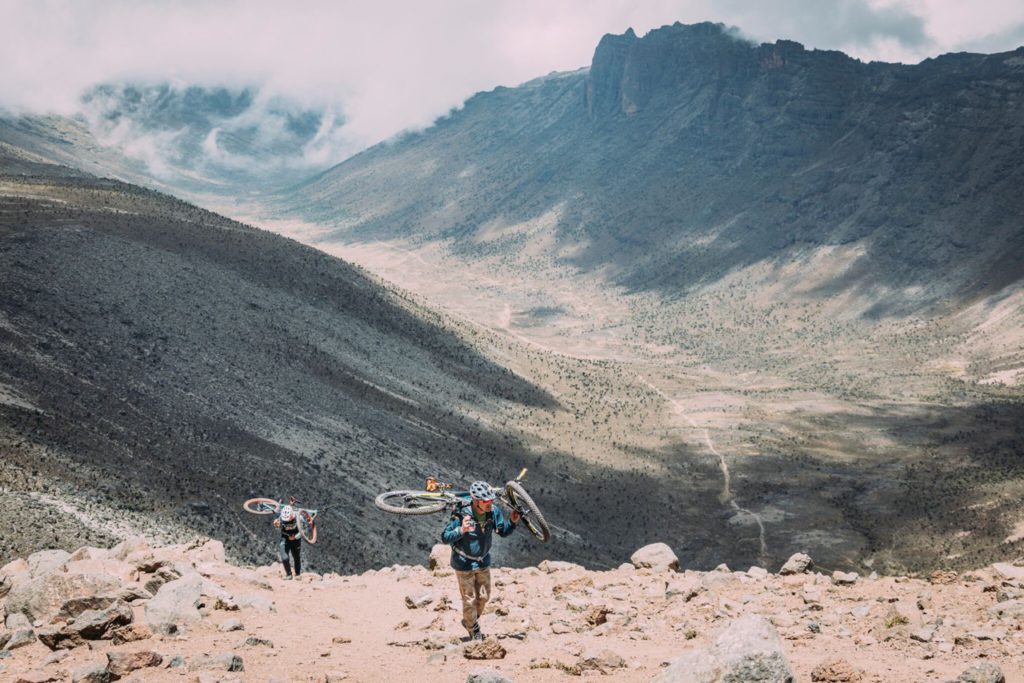 The highlight of the long drive to the foothills of Kilimanjaro near Moshi was at the very beginning of the day, just as we left our Camp near the base of Mt. Kenya we had a leopard cross the dirt road in front of us – it stood their for 30 seconds and stared at us, before it disappeared in the jungle. It was so cool and I was kind of glad I wasn’t on my bike – it is very rare to get to see one of those majestic animals up close in the wild.
The highlight of the long drive to the foothills of Kilimanjaro near Moshi was at the very beginning of the day, just as we left our Camp near the base of Mt. Kenya we had a leopard cross the dirt road in front of us – it stood their for 30 seconds and stared at us, before it disappeared in the jungle. It was so cool and I was kind of glad I wasn’t on my bike – it is very rare to get to see one of those majestic animals up close in the wild.
After one rest day near Kilimanjaro we were back on our bikes to start our 6 to 7 day trek up the tallest mountain on the continent.
 Until recently it was not allowed to ride mountain bikes in the Mount Kilimanjaro National Park. Only few parties had special permissions and taken their bikes to the top before our attempt. What I have not seen much were pictures or footage of any of them actually riding down, especially the crater descent. Originally I thought that it wouldn’t’ be the end of the world not to make it all the way to the summit, but once I was on the mountain, it wasn’t an option any longer not to make it all the way. But as we were warned and soon found out, carrying a bike and big daypack would up the anti by several levels.
Until recently it was not allowed to ride mountain bikes in the Mount Kilimanjaro National Park. Only few parties had special permissions and taken their bikes to the top before our attempt. What I have not seen much were pictures or footage of any of them actually riding down, especially the crater descent. Originally I thought that it wouldn’t’ be the end of the world not to make it all the way to the summit, but once I was on the mountain, it wasn’t an option any longer not to make it all the way. But as we were warned and soon found out, carrying a bike and big daypack would up the anti by several levels.
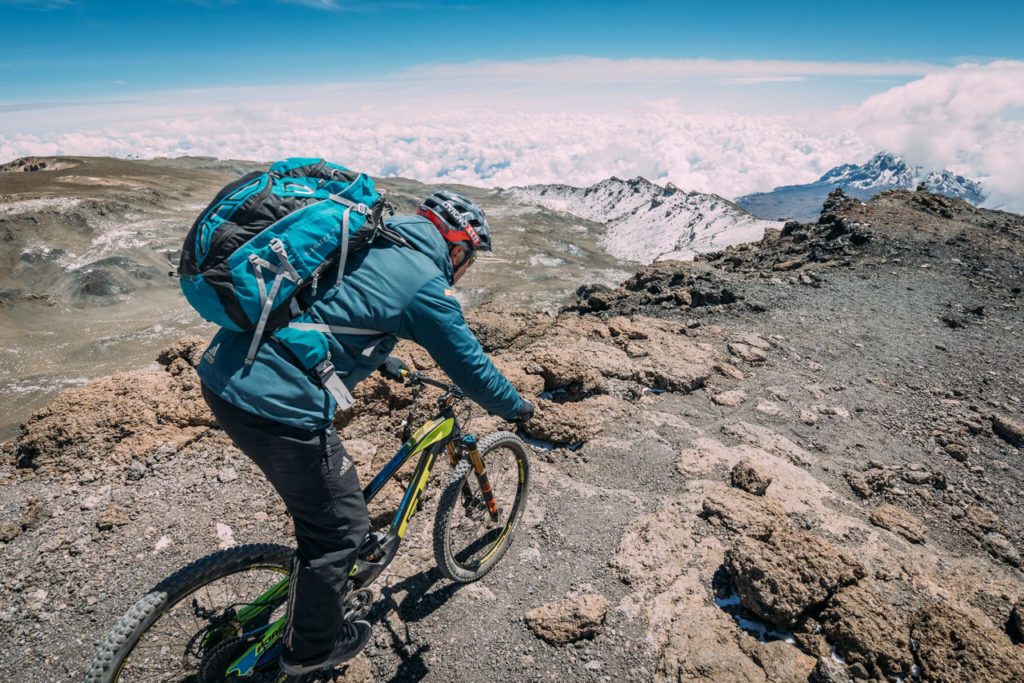 We were working with a different tour operator, guides and porters on this mountain than at Mt. Kenya. It was a first class service, but the guides would have to follow us on foot, which was easy for them on the way up but more challenging on the way down. First we had to officially sign in at the Marangu Park Gate, before we got diverted to the unofficial rescue road. Day 1 would be a long grind up a loose dirt road, 20km and 1700m/ 5600ft, which is not that much on a normal ride at lower elevation, but we started at an elevation of almost 2000m our camp was at 3700. That was a huge gain in elevation, normally the hikers take two days to get to Horombo Camp. But along the rescue road, there was nowhere opportunity to set up camp, therefore we had to do a long day and were at risk of getting the high altitude bug again. The first parts of the day we were in the forest and lot of the sections were ridable, but soon the track got steeper and looser, plus we didn’t want to push ourselves too hard, therefore we pushed the bikes for hours.
We were working with a different tour operator, guides and porters on this mountain than at Mt. Kenya. It was a first class service, but the guides would have to follow us on foot, which was easy for them on the way up but more challenging on the way down. First we had to officially sign in at the Marangu Park Gate, before we got diverted to the unofficial rescue road. Day 1 would be a long grind up a loose dirt road, 20km and 1700m/ 5600ft, which is not that much on a normal ride at lower elevation, but we started at an elevation of almost 2000m our camp was at 3700. That was a huge gain in elevation, normally the hikers take two days to get to Horombo Camp. But along the rescue road, there was nowhere opportunity to set up camp, therefore we had to do a long day and were at risk of getting the high altitude bug again. The first parts of the day we were in the forest and lot of the sections were ridable, but soon the track got steeper and looser, plus we didn’t want to push ourselves too hard, therefore we pushed the bikes for hours.
 Right before sunset we reached the camp, unlike in Kenya where we took advantage of the hut system, on Kilimanjaro we slept in tents. We had a fairly big group of porters and cooks to carry gear, tents, food and camera equipment. Even water had to be carried to certain camps. Personally I prefer the tent culture, it is far more fun and a lot cleaner and private. We spent Day 2 at Horombo to acclimate. On the rest day we carried our bikes up to Zebra Rock for further acclimation, took some photos and film and relaxed around the camp. Day 3 we would climb 1000m/1600ft to Kibo Hut. Kibo is the official name of Kilimanjaro crater. After about 2,5 hours we reached the big saddle near Mawenzi Peak, which is Kili’s sister summit. From there the view of Kilimanjaro was a lot different, than it looks in pictures or from the valley far below us. The last bit up the crater, which we would have to do on summit day, looked a lot bigger and steeper than expected. First we had to traverse the saddle between Mawenzi und Kilimanjaro to reach our camp. Midday it looked like the weather was turning on us, we had been pretty lucky weather-wise so far except for the first day on Kenya. We started to hurry as much as we could, between filming, resting, regrouping and putting our raingear on we made it to the camp before the rain. Danny was coping well and the rest of the team too. We had scheduled another acclimation day at Kibo Camp on Day 4. We used that day to climb 500m/1640ft up the mountain to leave our bikes there, so we wouldn’t have to lug them on the first part of the summit day. We went to bed quite early at 8pm; the plan was to wake up at 1am and start our walk with flashlights to the cave where we left our bikes soon after. When I opened my tent I was surprised by a 2-inch carpet of snow that covered our campsite and the entire mountain. That was a surprise and we didn’t know how much it had snowed on top. Our first reaction was to reconsider the departure time or even postpone by one day. Somebody quickly pointed out that the snow could be a blessing, and that the temperatures, which can be awfully cold on the crater and summit would be milder due to the cloud cover. As a matter of fact, I realized while on Mt. Kenya, that I had underestimated the potential weather extremes on Kilimanjaro. My biking shoes might have not been warm enough to protect me from the cold winds and temperatures one can get on Kibo. Usually when I go on these trips in Developing Countries I give a majority of my super functional gear to the porters afterwards, who often have very primitive equipment. This time it was reversed, a few days earlier I offered our guide on Kenya to buy his shoes, who happened to have a very nice insulated pair of Adidas Terrex shoes. Not having to worry about freezing my toes I was ready for summit day. Off we started at a very slow pace at 2am on Nov. 3rd 2017. We tramped a long-winding dark switchback line into the white snow. About 4:30
Right before sunset we reached the camp, unlike in Kenya where we took advantage of the hut system, on Kilimanjaro we slept in tents. We had a fairly big group of porters and cooks to carry gear, tents, food and camera equipment. Even water had to be carried to certain camps. Personally I prefer the tent culture, it is far more fun and a lot cleaner and private. We spent Day 2 at Horombo to acclimate. On the rest day we carried our bikes up to Zebra Rock for further acclimation, took some photos and film and relaxed around the camp. Day 3 we would climb 1000m/1600ft to Kibo Hut. Kibo is the official name of Kilimanjaro crater. After about 2,5 hours we reached the big saddle near Mawenzi Peak, which is Kili’s sister summit. From there the view of Kilimanjaro was a lot different, than it looks in pictures or from the valley far below us. The last bit up the crater, which we would have to do on summit day, looked a lot bigger and steeper than expected. First we had to traverse the saddle between Mawenzi und Kilimanjaro to reach our camp. Midday it looked like the weather was turning on us, we had been pretty lucky weather-wise so far except for the first day on Kenya. We started to hurry as much as we could, between filming, resting, regrouping and putting our raingear on we made it to the camp before the rain. Danny was coping well and the rest of the team too. We had scheduled another acclimation day at Kibo Camp on Day 4. We used that day to climb 500m/1640ft up the mountain to leave our bikes there, so we wouldn’t have to lug them on the first part of the summit day. We went to bed quite early at 8pm; the plan was to wake up at 1am and start our walk with flashlights to the cave where we left our bikes soon after. When I opened my tent I was surprised by a 2-inch carpet of snow that covered our campsite and the entire mountain. That was a surprise and we didn’t know how much it had snowed on top. Our first reaction was to reconsider the departure time or even postpone by one day. Somebody quickly pointed out that the snow could be a blessing, and that the temperatures, which can be awfully cold on the crater and summit would be milder due to the cloud cover. As a matter of fact, I realized while on Mt. Kenya, that I had underestimated the potential weather extremes on Kilimanjaro. My biking shoes might have not been warm enough to protect me from the cold winds and temperatures one can get on Kibo. Usually when I go on these trips in Developing Countries I give a majority of my super functional gear to the porters afterwards, who often have very primitive equipment. This time it was reversed, a few days earlier I offered our guide on Kenya to buy his shoes, who happened to have a very nice insulated pair of Adidas Terrex shoes. Not having to worry about freezing my toes I was ready for summit day. Off we started at a very slow pace at 2am on Nov. 3rd 2017. We tramped a long-winding dark switchback line into the white snow. About 4:30  am we reached our bikes as the morning sky started to get red in the East. Now the hard part was about to start, the air was getting thin and the strength in our bodies was nowhere near 100%. Religiously we were doing our breathing techniques, trying to find a rhythm in our pace, keeping warm and finding the most comfortable spot on our shoulders to carrying the bikes. Gerhard and Danny were using hiking poles; I managed to borrow a set from one of the cameramen, but felt more comfortable using just one single pole. It seemed to help especially once I found a way to balance the bike on my backpack and shoulders without using my hands. I don’t get easily emotional in life, it rarely happens on a trip like this or even when I used to win championships. But all of a sudden I became emotional, even tearing up a little. After planning this trip for over a year and after a turbulent last week and a half, I could almost see myself making it to the top. Only at that moment I realized what it meant to me to reach the summit, but I also knew that I still had the hardest part ahead of me. I was still about one hours walk below the Gilman’s Point, from where we would have to walk along the crater rim to Stella Point and onwards slightly uphill to the highest point on the crater. By the time we got to Gilman’s point, the sun started to warm up the air. It was a beautiful day. The crater was much bigger than I expected, it measures about 3km in diameter and is scattered with Glaciers, which have been rapidly shrinking in size in the past decades. At this point we saw more and more hikers who came to the crater from various routes. The last hour and half along the crater seemed to go on and on forever. After 7 hours we made it to Uhuru Peak at nearly 6000m/20,000ft.
am we reached our bikes as the morning sky started to get red in the East. Now the hard part was about to start, the air was getting thin and the strength in our bodies was nowhere near 100%. Religiously we were doing our breathing techniques, trying to find a rhythm in our pace, keeping warm and finding the most comfortable spot on our shoulders to carrying the bikes. Gerhard and Danny were using hiking poles; I managed to borrow a set from one of the cameramen, but felt more comfortable using just one single pole. It seemed to help especially once I found a way to balance the bike on my backpack and shoulders without using my hands. I don’t get easily emotional in life, it rarely happens on a trip like this or even when I used to win championships. But all of a sudden I became emotional, even tearing up a little. After planning this trip for over a year and after a turbulent last week and a half, I could almost see myself making it to the top. Only at that moment I realized what it meant to me to reach the summit, but I also knew that I still had the hardest part ahead of me. I was still about one hours walk below the Gilman’s Point, from where we would have to walk along the crater rim to Stella Point and onwards slightly uphill to the highest point on the crater. By the time we got to Gilman’s point, the sun started to warm up the air. It was a beautiful day. The crater was much bigger than I expected, it measures about 3km in diameter and is scattered with Glaciers, which have been rapidly shrinking in size in the past decades. At this point we saw more and more hikers who came to the crater from various routes. The last hour and half along the crater seemed to go on and on forever. After 7 hours we made it to Uhuru Peak at nearly 6000m/20,000ft.
 After a few moments on the summit taking it all in and high-fiving each other we turned around and started to reap in our awards. Of course we still had to do filming, and going down in the rough terrain was still very exhausting. The technical sections along the crater rim and the first section below it were challenging. Crashing or getting hurt was not an option.
After a few moments on the summit taking it all in and high-fiving each other we turned around and started to reap in our awards. Of course we still had to do filming, and going down in the rough terrain was still very exhausting. The technical sections along the crater rim and the first section below it were challenging. Crashing or getting hurt was not an option.
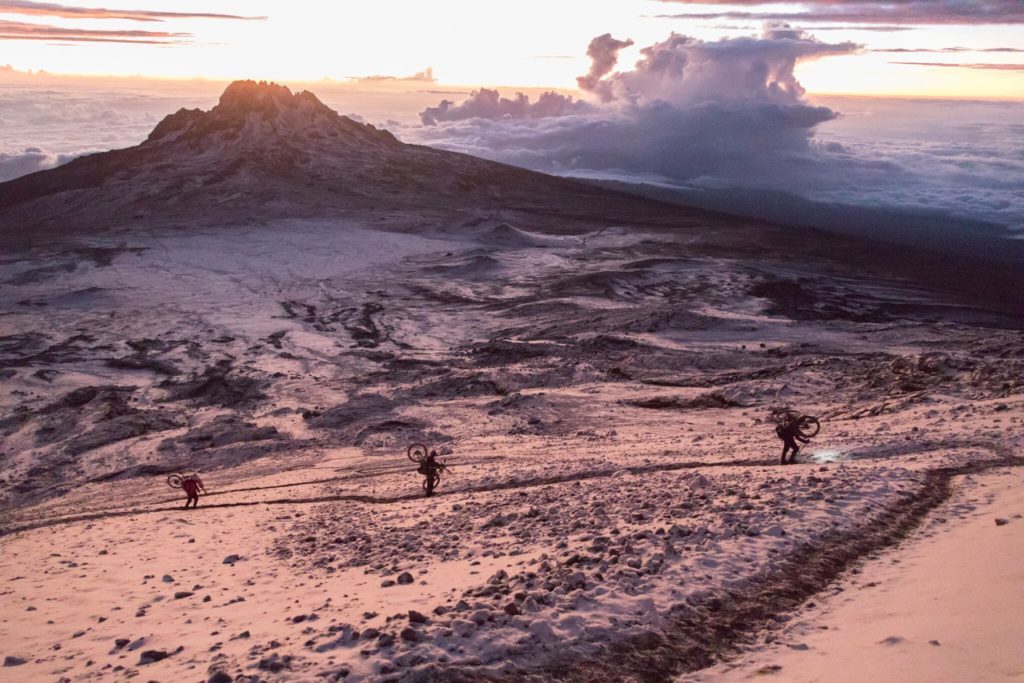 A few sections we had to dismount our bikes, but overall we could ride the majority. By now the snow had melted, the moisture in the ground improved traction and reduced dust. It was fun to let it rip for longer sections, but at the same time we had to do frequent stops to catch our breath. Danny was in his element, he loved to freeride and to carve turns like a skier in the soft soil. By mid afternoon we got back to our camp. Danny said it was by far the hardest thing he had ever done. Gerhard was stoked and relieved that we all had made it; afterall this trip was his idea and it had taken a lot of planning to pull this trip off. We were still far from the bottom of the mountain. The following night it snowed even more, the rainy season had arrived, conditions on the summit would have been harder and the weather was less favorable. We were happy that we ‘only’ had to ride down. The Advantage with our bikes was that we could do it all in one day, our guides had to leave camp early on foot and leapfrog ahead. As further down the slopes we got, the faster and less technical the route became. The ‘Kilimanjaro’ beers we got in the first village on the base of the mountain tasted like victory.
A few sections we had to dismount our bikes, but overall we could ride the majority. By now the snow had melted, the moisture in the ground improved traction and reduced dust. It was fun to let it rip for longer sections, but at the same time we had to do frequent stops to catch our breath. Danny was in his element, he loved to freeride and to carve turns like a skier in the soft soil. By mid afternoon we got back to our camp. Danny said it was by far the hardest thing he had ever done. Gerhard was stoked and relieved that we all had made it; afterall this trip was his idea and it had taken a lot of planning to pull this trip off. We were still far from the bottom of the mountain. The following night it snowed even more, the rainy season had arrived, conditions on the summit would have been harder and the weather was less favorable. We were happy that we ‘only’ had to ride down. The Advantage with our bikes was that we could do it all in one day, our guides had to leave camp early on foot and leapfrog ahead. As further down the slopes we got, the faster and less technical the route became. The ‘Kilimanjaro’ beers we got in the first village on the base of the mountain tasted like victory.
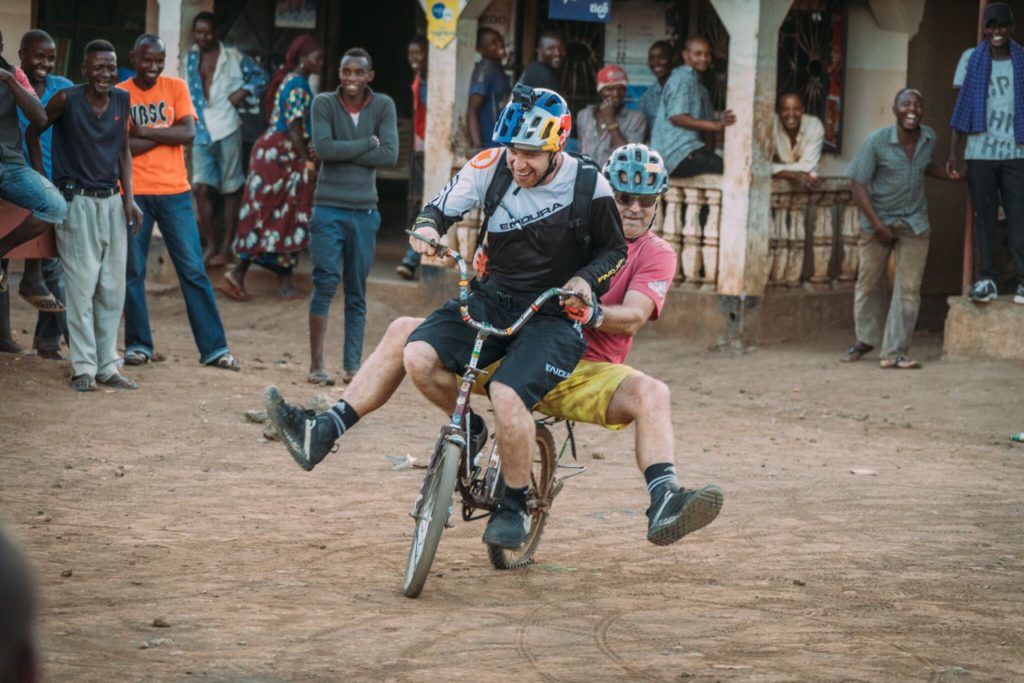 There were a lot of happy faces and it was a formal affair for everybody as they dressed in their church clothes.
There were a lot of happy faces and it was a formal affair for everybody as they dressed in their church clothes.


